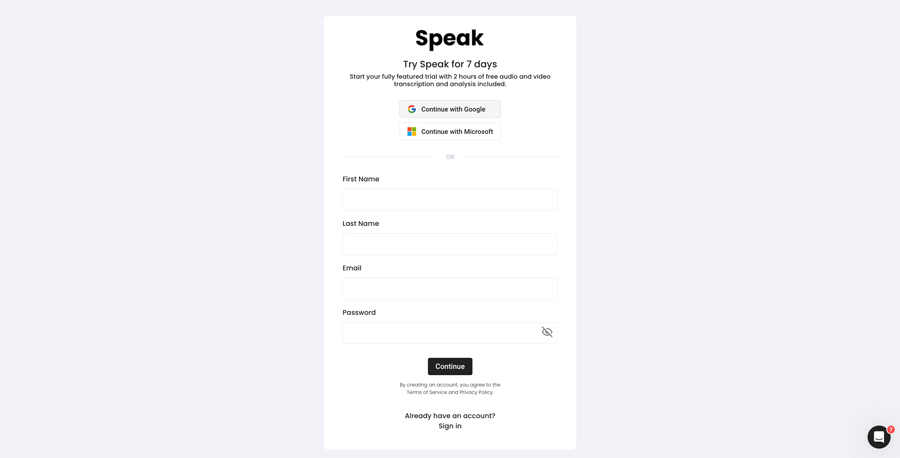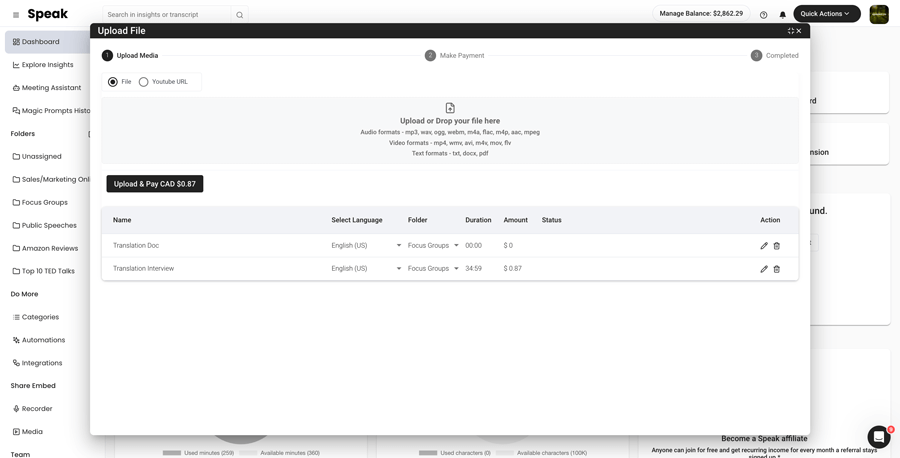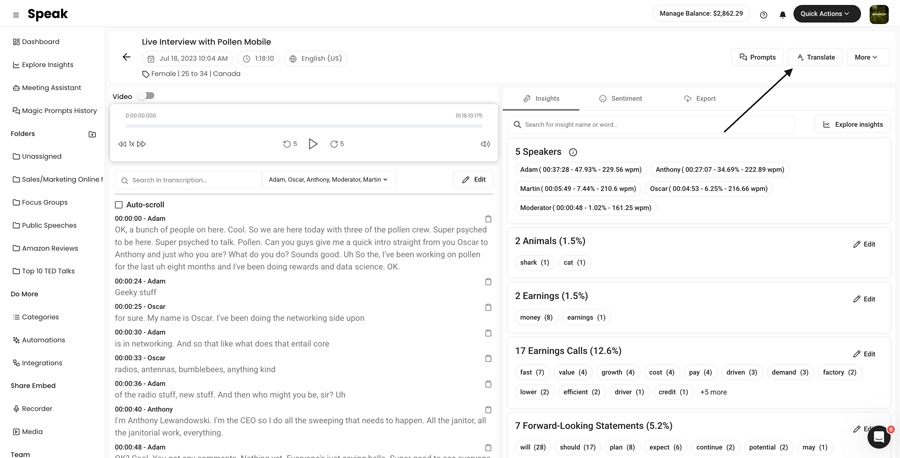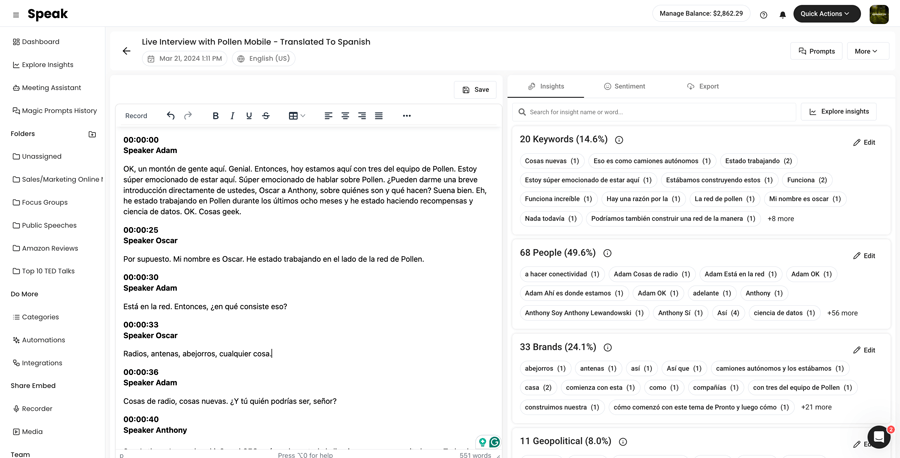How To Translate Pashto to Arabic (Oman)
Translating Pashto to Arabic (Oman) is super simple!

Step 1: Register for Speak
Register for Speak using this link.
Once you register, you can instantly begin translating your Pashto to Arabic (Oman) file(s).

Step 2: Upload Your Pashto file(s)
As soon as you log in, you will be redirected to the dashboard.
Once there, you can select the Quick Action "New Upload".
In Speak, you can seamlessly upload, transcribe and translate audio, video and text files all at once!

Step 3: Translate Your Pashto file(s) to Arabic (Oman)
Once the file is uploaded, simply visit your file and select "Translate".
If it is an audio and video file, Speak will ask you if you want to keep the speaker names and timestamps in the translation.
Want to translate many files at once? No problem!
You can view the files you want to automatically translate from Pashto to Arabic (Oman) from the folder level and instantly translate as many files as you need with our artificial intelligence translation in just a few clicks.

Step 4: That's It! View, Analyze, Modify & Export Your New Arabic (Oman) file(s)
Once the translation is done, you will be alerted and you will see a new document in the same folder your original file is in.
The file will be named the same but with a dash indicating that it is the translated version.
Need support with your Pashto translation?
We are always here and happy to help at Speak!
Just send us a message on live chat on the bottom right corner and we will ensure you are set up for success.
Interested in translating Pashto or other languages to different languages? View our entire list of supported translation languages here.
Automatic, accurate, instant AI translation from Pashto to Arabic (Oman) is here for you.
Register for Speak using this link and begin translating Pashto to Arabic (Oman) today.
Unlocking the Power of Language: Translate Pashto to Arabic (Oman)
In a world where languages build bridges between cultures and societies, the ability to communicate effectively across linguistic divides is more valuable than ever. This is particularly true for languages like Pashto and Arabic (Oman), each with rich histories and cultural significance. For researchers and businesses alike, navigating these languages efficiently can unlock numerous opportunities. Speak AI stands at the forefront of this linguistic revolution, harnessing AI translation, automatic translation, and translator technologies to seamlessly convert Pashto to Arabic (Oman) translation.
Why Translate Pashto to Arabic (Oman)?
In the global village of today, communication barriers are meant to be broken. Translating Pashto to Arabic (Oman) is not just about converting text; it's about opening channels for dialogue, trade, cooperation, and understanding between two rich cultures. Whether you're a scholar researching Middle Eastern culture, a business looking to expand in the Gulf region, or a content creator reaching out to new audiences, the value here is immense.
Bridging Cultures with Technology
Speak AI is at the heart of this cultural exchange. With its state-of-the-art NLP (Natural Language Processing), large language models, data visualization, and Generative AI, Speak AI's software translates not just words but contexts and nuances from Pashto to Arabic (Oman). The AI Meeting Assistant further revolutionizes this by joining calls on platforms like Microsoft Teams, Zoom, Google Meet, and Webex to automatically transcribe, translate, and analyze conversations.
The Advantages of AI-Powered Translations
- Accuracy and Efficiency: AI translations ensure a higher level of accuracy at a fraction of the time it takes human translators.
- Cost Savings: Automating the translation process significantly reduces costs, making it an economical choice for businesses and researchers.
- Scalability: From a few lines of text to large volumes of data, Speak AI's software scales with your needs, providing consistent quality and reliability.
- Improved Communication: With real-time translations, international communication becomes seamless and more productive.
Real-World Use Cases
- Business Expansion: Companies looking to enter or expand in the Gulf market can localize their offerings and marketing materials efficiently.
- Academic Research: Scholars analyzing texts or conducting interviews across these languages can save time and resources on translations.
- Content Localization: Media producers can make their content accessible to vastly different linguistic audiences, enhancing viewer engagement.
The Fascinating Worlds of Pashto and Arabic (Oman)
Pashto and Arabic (Oman) are more than just languages; they are portals to diverse histories, cultures, and philosophies. Understanding their intricacies not only enriches the translation process but also fosters a deeper appreciation of their speakers' worlds.
Locations and Popularity
Pashto is predominantly spoken in Afghanistan and Pakistan, with a rich diaspora around the globe. It's an Indo-Iranian language with approximately 40-60 million speakers. Arabic (Oman), a dialect of Modern Standard Arabic, is spoken in Oman and the GCC (Gulf Cooperation Council) countries. Oman, with its vibrant history as a maritime empire, presents a unique blend of ancient and modern Arabic linguistic traits.
Fun Facts
- Pashto is known for its poetry, particularly its Pashto landai, which are two-line poetic forms.
- Arabic (Oman) has preserved numerous archaic words and phrases that can be traced back to ancient inscriptions.
Differences and Similarities
While Pashto and Arabic (Oman) stem from different language families (Indo-European and Semitic, respectively), they share the Islamic cultural sphere's influence, incorporating many Persian and Arabic loanwords. A significant difference lies in their scripts and phonetics, with Pashto using the Pashto alphabet (an extension of the Arabic script) and Arabic using the Arabic script.
Conclusion: Bridging Languages, Cultures, and Businesses
Translating Pashto to Arabic (Oman) opens up a myriad of possibilities for cultural exchange and business ventures. With Speak AI, the process is not just about conversion but about understanding and engaging with the content on a deeper level. By tapping into the nuances of these languages, Speak AI helps users navigate new landscapes of communication and collaboration with ease. Join over 150K users who have experienced the transformative powers of Speak AI and elevate your cross-cultural and business communications today.
---
To answer the questions separately:
- **Locations where Pashto and Arabic (Oman) are popular**: Pashto is widely spoken in Afghanistan and Pakistan, with significant communities in Iran, UAE, and other countries due to migration. Arabic (Oman), a dialect of Modern Standard Arabic, is spoken primarily in Oman, part of the Arabian Peninsula.
- **Interesting stats**: There are an estimated 40-60 million Pashto speakers worldwide. Oman, with a population of over 4 million people, predominantly speaks the Arabic (Oman) dialect.
- **Fun facts about Pashto and Arabic (Oman)**: Pashto literature is famed for its emotional depth, especially in poetry, carrying a long tradition of oral storytelling. Arabic (Oman) retains several ancient linguistic features and lends insight into the region's rich history and traditions.
- **Differences and similarities between Pashto and Arabic (Oman)**: The key difference lies in their linguistic roots—Pashto is part of the Indo-European family while Arabic (Oman) comes from the Semitic group. They share many cultural and historical links due to the spread of Islam, resulting in a significant exchange of loanwords and cultural concepts.
Translate Pashto To These Other Supported Languages:
- Translate Pashto-to-Afrikaans
- Translate Pashto-to-Albanian
- Translate Pashto-to-Amharic
- Translate Pashto-to-Arabic (Egypt)
- Translate Pashto-to-Arabic (Iraq)
- Translate Pashto-to-Arabic (Israel)
- Translate Pashto-to-Arabic (Jordan)
- Translate Pashto-to-Arabic (Kuwait)
- Translate Pashto-to-Arabic (Lebanon)
- Translate Pashto-to-Arabic (Oman)
- Translate Pashto-to-Arabic (Palestinian Authority)
- Translate Pashto-to-Arabic (Qatar)
- Translate Pashto-to-Arabic (Saudi Arabia)
- Translate Pashto-to-Arabic (Syrian Arab Republic)
- Translate Pashto-to-Arabic (United Arab Emirates)
- Translate Pashto-to-Arabic Modern Standard (Bahrain)
- Translate Pashto-to-Armenian
- Translate Pashto-to-Assamese
- Translate Pashto-to-Aymara
- Translate Pashto-to-Azerbaijani
- Translate Pashto-to-Bambara
- Translate Pashto-to-Basque
- Translate Pashto-to-Belarusian
- Translate Pashto-to-Bengali
- Translate Pashto-to-Bhojpuri
- Translate Pashto-to-Bosnian
- Translate Pashto-to-Bulgarian
- Translate Pashto-to-Catalan
- Translate Pashto-to-Cebuano
- Translate Pashto-to-Chinese (Simplified)
- Translate Pashto-to-Chinese (Traditional)
- Translate Pashto-to-Corsican
- Translate Pashto-to-Croatian
- Translate Pashto-to-Czech
- Translate Pashto-to-Danish
- Translate Pashto-to-Dari
- Translate Pashto-to-Dhivehi
- Translate Pashto-to-Dogri
- Translate Pashto-to-Dutch
- Translate Pashto-to-English
- Translate Pashto-to-English (Australia)
- Translate Pashto-to-English (Indian)
- Translate Pashto-to-English (Irish)
- Translate Pashto-to-English (New Zealand)
- Translate Pashto-to-English (Scottish)
- Translate Pashto-to-English (South African)
- Translate Pashto-to-English (United Kingdom)
- Translate Pashto-to-English (United States)
- Translate Pashto-to-Esperanto
- Translate Pashto-to-Estonian
- Translate Pashto-to-Ewe
- Translate Pashto-to-Farsi (Persian)
- Translate Pashto-to-Filipino Tagalog
- Translate Pashto-to-Finnish
- Translate Pashto-to-French
- Translate Pashto-to-French (Canada)
- Translate Pashto-to-Frisian
- Translate Pashto-to-Galician
- Translate Pashto-to-Georgian
- Translate Pashto-to-German
- Translate Pashto-to-German (Swiss)
- Translate Pashto-to-Greek
- Translate Pashto-to-Guarani
- Translate Pashto-to-Gujarati
- Translate Pashto-to-Haitian Creole
- Translate Pashto-to-Hausa
- Translate Pashto-to-Hawaiian
- Translate Pashto-to-Hebrew
- Translate Pashto-to-Hindi
- Translate Pashto-to-Hmong
- Translate Pashto-to-Hungarian
- Translate Pashto-to-Icelandic
- Translate Pashto-to-Igbo
- Translate Pashto-to-Ilocano
- Translate Pashto-to-Indonesian
- Translate Pashto-to-Irish
- Translate Pashto-to-Italian
- Translate Pashto-to-Japanese
- Translate Pashto-to-Javanese
- Translate Pashto-to-Kannada
- Translate Pashto-to-Kazakh
- Translate Pashto-to-Khmer
- Translate Pashto-to-Kinyarwanda
- Translate Pashto-to-Konkani
- Translate Pashto-to-Korean
- Translate Pashto-to-Krio
- Translate Pashto-to-Kurdish
- Translate Pashto-to-Kurdish (Sorani)
- Translate Pashto-to-Kyrgyz
- Translate Pashto-to-Lao
- Translate Pashto-to-Latin
- Translate Pashto-to-Latvian
- Translate Pashto-to-Lingala
- Translate Pashto-to-Lithuanian
- Translate Pashto-to-Luganda
- Translate Pashto-to-Luxembourgish
- Translate Pashto-to-Macedonian
- Translate Pashto-to-Maithili
- Translate Pashto-to-Malagasy
- Translate Pashto-to-Malay
- Translate Pashto-to-Malayalam
- Translate Pashto-to-Maltese
- Translate Pashto-to-Maori
- Translate Pashto-to-Marathi
- Translate Pashto-to-Meiteilon (Manipuri)
- Translate Pashto-to-Mizo
- Translate Pashto-to-Mongolian
- Translate Pashto-to-Myanmar (Burmese)
- Translate Pashto-to-Nepali
- Translate Pashto-to-Norwegian
- Translate Pashto-to-Nyanja (Chichewa)
- Translate Pashto-to-Odia (Oriya)
- Translate Pashto-to-Oromo
- Translate Pashto-to-Pashto
- Translate Pashto-to-Persian
- Translate Pashto-to-Polish
- Translate Pashto-to-Portuguese
- Translate Pashto-to-Portuguese (Brazilian)
- Translate Pashto-to-Portuguese (Portugal)
- Translate Pashto-to-Punjabi
- Translate Pashto-to-Quechua
- Translate Pashto-to-Romanian
- Translate Pashto-to-Russian
- Translate Pashto-to-Samoan
- Translate Pashto-to-Sanskrit
- Translate Pashto-to-Scots Gaelic
- Translate Pashto-to-Sepedi
- Translate Pashto-to-Serbian
- Translate Pashto-to-Sesotho
- Translate Pashto-to-Shona
- Translate Pashto-to-Sindhi
- Translate Pashto-to-Sinhala
- Translate Pashto-to-Sinhala (Sinhalese)
- Translate Pashto-to-Slovak
- Translate Pashto-to-Slovenian
- Translate Pashto-to-Somali
- Translate Pashto-to-Spanish
- Translate Pashto-to-Spanish (Mexico)
- Translate Pashto-to-Sundanese
- Translate Pashto-to-Swahili
- Translate Pashto-to-Swedish
- Translate Pashto-to-Tajik
- Translate Pashto-to-Tamil
- Translate Pashto-to-Tatar
- Translate Pashto-to-Telugu
- Translate Pashto-to-Thai
- Translate Pashto-to-Tigrinya
- Translate Pashto-to-Tsonga
- Translate Pashto-to-Turkish
- Translate Pashto-to-Turkmen
- Translate Pashto-to-Twi (Akan)
- Translate Pashto-to-Ukrainian
- Translate Pashto-to-Urdu
- Translate Pashto-to-Uyghur
- Translate Pashto-to-Uzbek
- Translate Pashto-to-Vietnamese
- Translate Pashto-to-Welsh
- Translate Pashto-to-Xhosa
- Translate Pashto-to-Yiddish
- Translate Pashto-to-Yoruba
- Translate Pashto-to-Zulu



